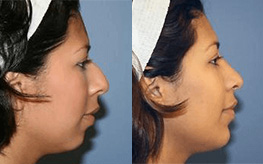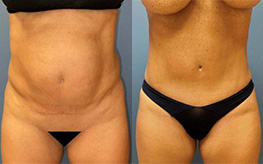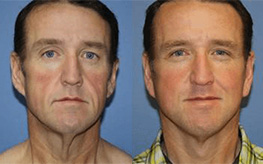If you’re considering breast augmentation in Santa Rosa, you’ve probably wondered about your breast implant options. There are two primary classes of breast implants available: saline and silicone. Both are FDA-approved, have strong safety records, and can achieve natural-looking breast augmentation results.
Each implant type comes in a wide range of size and shape options, can be placed under the muscle (submuscular) or over the muscle (subglandular), and features unique advantages worth considering. Saline or silicone breast implants can be used in almost all breast enhancement surgeries including:
In contrast, implants are not used to enhance the breast appearance in a fat transfer breast enlargement procedure.
To support you in choosing an implant type that will best fit your goals and lifestyle, our Northern California plastic surgery experts here explain when each type of breast augmentation can be the best choice to suit your breast enhancement goals.
Both saline and silicone breast implants are FDA-approved, have strong safety records, and can achieve natural-looking breast augmentation results.
Contents
Saline implants in Santa Rosa
Saline implants have been a safe and reliable implant option for breast augmentation since 1964, when they were introduced as an alternative to silicone implants. Saline implants are available in a range of sizes and implant profiles, and consist of a flexible silicone outer container filled with saline solution (sterile salt water). Typically, saline implant shells are situated in the breast pocket and then filled to the desired volume via an injection port. This technique allows for shorter breast augmentation incisions and scars.
Advantages of saline breast implants
Because they feel somewhat less natural, saline breast implants are chosen less frequently than silicone implants—though they can achieve beautiful, natural-looking breast augmentation results for the right patient. Saline implants may be the right choice for you based on a number of factors.
They are FDA-approved for patients 18+
Saline implants are FDA-approved for patients aged 18+ (silicone implants are approved for patients 22+). The age requirement for silicone implants is not due to safety concerns for younger patients, but rather because the patients in clinical safety studies to gain FDA approval were all 22 years or older. Many women younger than 22 still choose silicone implants with the full support of their plastic surgeon—though some breast implant manufacturers may void the warranty if placement occurred before the age of 22.
You have more incision site options
Saline implants are usually filled after being situated into the breast pocket, allowing your plastic surgeon to make smaller access incisions (about an inch long). This allows for alternative breast augmentation incision sites for saline implant placement and results in shorter scars.
Your surgeon can make refined volume adjustments
Because most saline implants are manually filled after placement, the surgeon has increased control over how much volume is added. This allows your surgeon to make refined size adjustments and improve breast symmetry. (Different sizes of silicone implants can also improve balance between different-sized breasts, but you and your surgeon must choose among existing cc size options.)
No need for implant rupture monitoring
Saline moves freely and has the same consistency as water so if a saline implant ruptures, it will flatten as it drains—making any rupture obvious. Furthermore, the sterile solution will then be absorbed and safely expelled from your body through your natural elimination processes.
In contrast, silicone implant ruptures are not obvious—particularly with today’s cohesive fills which are too thick to migrate in the body—and thus the FDA recommends that patients optionally get routine ultrasound or MRI scans to check for “silent” implant ruptures 5 years after placement and every 2-3 years for the lifespan of their silicone implants.
Cost
While it’s not always the case, saline implants may cost slightly less than silicone implants. That said, breast augmentation achieves long-lasting results so we strongly encourage you to choose the implant you are most comfortable with for the foreseeable future; most Northern California plastic surgery practices will offer convenient financing options to alleviate concerns about pricing differences.
What are the disadvantages of saline breast implants?
The disadvantages of saline implants include:
- A heavier, firmer feel
- Will noticeably flatten if ruptured
- More visible rippling and wrinkling for some patients
Silicone breast implants in Santa Rosa
Introduced in the 1960s, silicone implants were the first promising alternative to failed breast enhancement materials such as glycerine and ox cartilage. Like saline implants, silicone breast implants also have a flexible silicone outer shell—but they come pre-filled with a cohesive silicone gel. They are available in a wide variety of shapes, sizes, and profiles.
Previous incarnations of silicone breast implants were pulled from the market in 1991 as reports of migrating silicone were linked to “silicone illness.” While only a minority of patients experienced problems, it is clear the combination of a thinner barrier shell and liquid fill materials made these implants less stable and manufacturers went through extensive redesign and testing over the course of the following fifteen years. Silicone implants were reintroduced to the general market in 2006 with FDA approval featuring safer, advanced shell technology and a cohesive gel fill. Today, most patients prefer silicone breast implants for their natural feel and enhanced safety and durability features.
Advantages of silicone breast implants
The more popular choice among Santa Rosa breast augmentation patients, silicone breast implants are preferred for the following reasons.
A more natural look and feel
Silicone implants generally appear more natural in how they behave—plus the “gumminess” of the cohesive gel more closely mimics the feel of natural breast tissue, which is ideal for patients who desire a more discreet enhancement.
More shaped implant options
Silicone implants feature a wider range of shapes and profiles to complement your unique proportions and achieve the results you are looking for.
Ideal for thinner breast tissue
Patients with naturally smaller breasts may not have enough mammary tissue to sufficiently cover slight visible wrinkling in saline implants. In contrast, silicone gel fill is more viscous, and pre-filled implants are less likely to experience rippling. Thus silicone implants are commonly the best implant choice for patients with thinner tissues.
What are the disadvantages of silicone breast implants?
The disadvantages of silicone implants include:
- Fewer incision site options
- Slightly longer scars
- Are not FDA-approved for patients younger than 22 (i.e. can only be used “off-label” for ages 18-21)
- Recommended MRI or ultrasound screenings to monitor for or detect ruptures
Considering breast augmentation in Santa Rosa?
Board certified plastic surgeons Dr. Heather Furnas, Dr. Francisco Canales, and Dr. Eric Culbertson will listen to your goals and help you select the ideal breast implant type, size, and style to complement your physique and achieve your desired look. In addition to breast augmentation surgeries, our highly-experienced Santa Rosa plastic surgeons offer a full range of face and body procedures to fully rejuvenate your appearance at Plastic Surgery Associates and regularly welcome out-of-town patients to their practice.
Schedule your personal consultation by calling our practice at 707-537-2111 or contacting us online.





